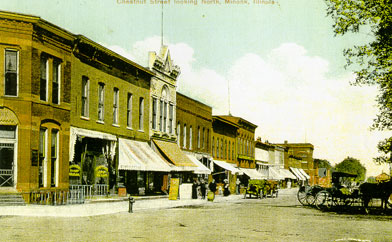One can learn a lot about the lives of Minonk's residents from the newspaper archives of the Minonk News-Dispatch. Let us step back in time to the year 1902 and articles published by C. R, Denson, the old-time historian, Babe Smith and an unidentified man who came to Minonk for a visit that year.
1902 had been a rainy year with water standing all over town, in some places the size of small lakes. There were no paved streets and only a few blocks of brick sidewalks. The old boardwalks were torn up the year before and replaced with cinders.
Needless to say, the streets were muddy and "Main Street" was more like a "hog wallow" than a public highway. People were wading in mud up to their shoe tops. Planks were laid at the bank corner so pedestrians could cross the street.
Very few people had city water and there was no sewage system except for numerous tiles laid here and there. Only a few households had installed wooden, zinc-lined bathtubs. There were hardly any toilets. It was said that instead of baths there were paths.
Electricity, furnished by a gasoline engine driven generator, was available from sundown to sun-up.
No one in Minonk owned an automobile.
The old city hall on West Fifth Street looked like an old cow barn ready to fall down. The fire equipment consisted of a horse cart pulled by hand.
The closing of the coal mine over a year before added to the bleakness. Miners were working in Rutland, Wenona, Toluca and Roanoke. Many had moved to these towns.
The so-called city park was like a swamp with a dense growth of small trees, dead leaves and no grass.
Some of the problems were solved in 1903 when Herman B. Meils was elected mayor. During his administration, the first two blocks of paving were installed on Main Street, as well as miles of concrete sidewalk. The city hall on West Fifth Street was replaced.
About the same time, W.G. Sutton and J.S. Webber of Rutland came to Minonk and re-opened the mine. In 1902 John Vissering was mayor, P. M. Burton, the city clerk and A. C. Fort, the city attorney.
There were four hotels in town, the Woodford; the Dasher, which was getting the most business; the Arlington on the southwest corner of West Fifth and Walnut and James McGrails' City Hotel on the southeast corner of East Fifth and Oak.
The largest industry in town was the Priebe-Simater poultry house located in the 600 block of Chestnut. Minonk also had four grain elevators, two brickyards, two cigar factories, nine saloons, a pop factory, a mill and a feed barn.
Doctors, dentists, attorneys and a veterinarian surgeon had practices. There was no need to go to another town to shop because Minonk had it all.
Minonk had an implement store, lumber yards, repair shops and hardware stores.
There were barbershops, drug stores and meatmarkets. Blacksmith shops, a harness store, a feed store and a livery stable operated in town. Clothing stores, shoe stores, milliners and a jewelry store offered the latest fashions for men and women. Sam Lee's Chinese Laundry rounded out the list of Minonk's businesses.
In old pictures, women wore long skirts, fitted jackets, white or striped blouses and large hats.
Men wore dark suits, vests, white shirts, ties and hats. Young boys wore knickers and girls wore dresses just below the knees with dark stockings.
Those were the days my friends, or so they say. Life has to be easier today but life in 1902 would have been very event!
North Chestnut Street Minonk in 1906
